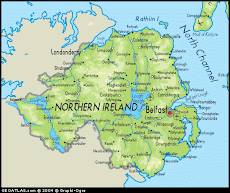After nearly seven months on the Emerald Isle, working and living in what was once one of the most volatile and violent places on Earth, there is a recurring question that keeps popping up from back home: ‘Why is so much animosity still present in Northern Ireland? With as far as they’ve come, why is there still so much hatred?’ Good question. I’ve posed this to some people who I’ve gotten to know here; some of the women and the men who I work with on a daily basis, who grew up here, who lived through the Troubles and who are now trying to live on the other side of it. Unfortunately, they don’t know either. It all goes back to 1640 when the whole Plantation began. (If you haven’t read ‘History Lesson,’ or if it’s been a while, pause now to go back and get the nutshell history of Northern Ireland from the 1640’s to the present.)
As far as I can see, and as far as a lot of people are concerned, it’s more a habit than anything else. Catholics hate Protestants. It’s just how it is. But the odd thing is I haven’t seen this attitude played out except in a select few instances. (So select, in fact, I can count them on one hand with fingers left over.) I work with two men in the Men’s Group at WAVE, Gary and Ciran. Gary grew up in the Shankill (read: Protestant) and Ciran grew up in the Falls (read: Catholic.) Even today people from these bordering neighborhoods in West Belfast don’t mix, or mix rarely but only in neutral territory, but Gary and Ciran are nearly inseparable. By their own admission they probably grew up throwing rocks and bottles at each other and setting fire to each other’s houses. But they’ve managed to gain a sense that there has to be something bigger than all this fighting; there has to be something else than carrying around hatred for your whole life. They’ve managed to find the human in each other and it’s a pretty cool thing.
St. Patrick’s Day has just passed, and yes, it was quite an experience. Apart from the fact that we (the other YAVs and I) were able to celebrate St. Paddy’s in Ireland (the island of Ireland, not the country) was pretty cool. But it was also quite an experience to see how much of a cross-community event it was. Typically, St. Pat’s is seen as a ‘Catholic holiday’ while the 12th of July is seen as a ‘Protestant holiday.’ (That gets us into marching season and bonfires, which we’ll cover when we get there. But back to March 17.) There was a parade from City Hall with floats and bands and performers and all the usual parade paraphernalia. There was green everywhere—of course—and lots of flags. The Irish Tri-Color was flown, worn, paraded, painted and displayed by nearly everyone. But even St. George’s Cross, the flag most associated with Ulster and Protestantism, was displayed and used in the parade. There was nothing but a jovial atmosphere, a celebratory time, people enjoying being off work and out of school. It was also a gorgeous day with clear sunny skies. Even at the pubs later that day and into the evening it was upbeat, pleasant and like any other holiday. (For pictures, click the link at left for the web album 'Pipes, Pints and Patrick'.) Prior to the holiday I kept getting warnings from people to stay out of certain places—mostly around the university area—since riots and fights were expected. My thought was, ‘Does this have more to do with St. Patrick’s Day in a religiously and politically unstable environment or the fact that large numbers of college students living in one of the most densely populated areas in the UK have an excuse to drink mass quantities of alcohol?’ Having been a recent college student, I’m gonna say the latter. (Not to say that politics and religion didn’t play any role at all, but as far as I know, there were no major riots or fights this year.)
Many of the youth that I work with go to integrated schools and have Catholic friends (and Muslim friends and agnostic friends and gypsy friends…) and they don’t see the big deal either. Now, they’re not necessarily going to go running through the opposing neighborhood at night waving a Union Jack, but at least they know and admit that there are real people, kids just like themselves, on the other side of that peace wall. That’s a big step forward.
So why all the animosity still? It doesn’t appear that anyone knows. Why have more miles of peace wall gone up in the last 12 years since the ‘Good Friday’ Agreement than in the 30 years before it? I can’t tell you. But is there hope? Yes. And is there love? Yes. Eventually, I’m sure we won’t need the answers to these questions anymore, because no one will have a reason to ask them.

